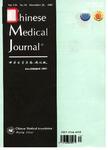Cloning and characterization of cholesteryl ester transfer protein isolated from the tree shrew
Cloning and characterization of cholesteryl ester transfer protein isolated from the tree shrew作者机构:Department of Biochemistry and Molecular BiologyChinese Academy of Medical SciencesPeking Union Medical CollegeBeijing 100005China
出 版 物:《Chinese Medical Journal》 (中华医学杂志(英文版))
年 卷 期:2003年第116卷第6期
页 面:928-931页
核心收录:
学科分类:1001[医学-基础医学(可授医学、理学学位)] 10[医学]
主 题:tree shrew·arteriosclerosis·cholesterol ester transfer protein·cDNA sequence
摘 要:Objective To obtain the nucleotide sequence and deduced amino acid sequence of cholesteryl ester transfer protein (CETP) cDNA from the tree shrew (Tupaia glis). Methods The cDNA sequence of the tree shrew CETP was obtained by utilizing the technique of switching mechanism at 5 end of RNA transcript (SMART) and rapid amplification of cDNA end (RACE) from the first strand of the cDNA. The amino acid sequence of CETP was deduced from the cDNA sequence and its primary and secondary structures were predicted. Results The sequence of CETP cDNA from tree shrew (GenBank accession number AF334033) covers 1636 bp, including 178 bp at the 3 end of the untranslated region and a 1458 bp fragment in a coding region, which provides the complete sequence of mature tree shrew CETP, although not the initiator methionine. The first 24 bp encodes a partial signal peptide. The mature protein consists of 477 amino acids and is longer than the human version by one amino acid (Gly318). Comparing this amino acid sequence with those of other animals CETPs, the identity between tree shrew and human and rabbit CETP is 88% and 82%, respectively. The protein is extremely hydrophobic as it contains many hydrophobic residues, especially at the C-terminal, consistent with its function in the transfer of neutral lipids. The amino acid residues concerning with binding and transferring neutral lipids are highly conserved. There is a deletion of an N-linked glycosylation site at Asn342 in the tree shrew CETP protein that may participate in the removal of peripheral cholesterol and cholesteryl ester by increasing its activity of transferring cholesteryl ester. Conclusion The possible glycosylation in the tree shrew CETP may be involved in the molecular mechanism of its insusceptibility to atherosclerosis.



